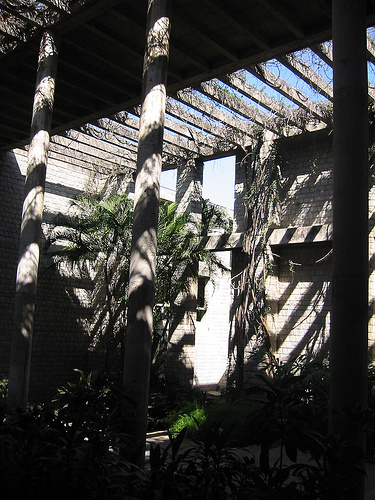photo credit: Paul Miller
“Form Follows Climate “, Charles Corrrea, a famous Indian architect once said. This idea essentially suggests that a built environment should respond to climate or use it as an advantage. However it’s not a new thought, traditionally most buildings fundamentally responded to climate. For instance, if you look at the indigenous development in Coastal India, most of the structures had sloping roofs in response to the heavy rains. But with globalization hitting architecture – we seem to be loosing out on many of these wonderful indigenous design solutions.
These eco friendly practices also results in more attractive living spaces with open, naturally lit spaces and fresh air movement. Solar passive or climatic design creates a comfortable setting and can also have an enormous impact on reducing operating costs of a building. By logically applying design principles that capture natural breezes and the sun’s energy and light- energy uses in buildings can be reduced considerably. A building that responds to climates essentially harvests light, air and water by using various design techniques. These practices can also not only improve the environment but also strengthen the economy by cutting down the need for fossil fuels and nuclear energy.
Day lighting
Day lighting or the use of natural light in a building is one of the fundamental elements of a climatic design. It reduces the need for electric lights and improves the visual quality of a space. The most common ways to get daylight into a building is to increase the number and size of glazed areas in a building. There are various architectural designs or techniques that accomplish this, including conventional windows, atriums and skylights. Windows are the most common means of day lighting. An atrium is an interior courtyard – could be covered with glazing or a transparent skylight, to allow direct and diffused sunlight into the building. Rooms adjoining the atrium benefit from daylight entering through the glazed roof. A skylight is a transparent panel set into a roof that allows direct and diffuse sunlight into the building.
Building orientation is an important parameter for a climatic responsive building. The amount of day light received by a building is determined by its orientation. And the north direction is considered ideal as it receives uniform uninterrupted light through the day, so most of the living spaces can be positioned accordingly. Design approaches can also shut out excess heat from entering the living spaces. With clever orientation you could protect the harsh south west radiation from coming into the building. Further using solar shade screens, roof overhangs, awnings, trees and other landscaping can also shade the indoors.
Wind
The use of natural winds to enhance the living environment is another solution offered by climatic design. To improve cooling, a building’s windows should be placed and designed to capture prevailing winds. The use of “venturi effect” is another interesting idea. It is essentially about looking at design in volumes i.e. when you force a wind to move into a narrow opening and expand into a larger volume, the effect can be quite incredible. This design strategy creates what is referred to as “wind tunnels” and keeps the living spaces cool and airy. This concept is best exemplified in IIM, Bangalore, where the architects have created varying volumes to enhance wind movement and cooling. And in some points in the campus, the effect of wind movement is truly remarkable. Cross ventilation is yet another idea. It involves a window that opens to the wind allowing breezes into the building and another window on the opposite side that lets stagnant air to be flushed out .This strategy creates continuous air movement in a space.
Landscape
Landscaping is another design tool. For example, extensive use of trees minimizes heat build-up around buildings. Placing trees along the southern face of a building will provide shade and heat reduction in the summer. In addition, fairly dense planting around houses can direct breezes for natural cooling. Another innovative idea would be to have a water body around the prevailing wind direction. And when the wind moves over the water body onto the living spaces, it can bring in gushes of cool breeze.

